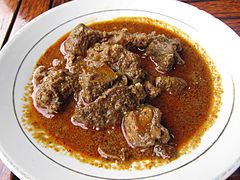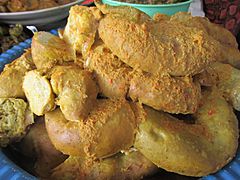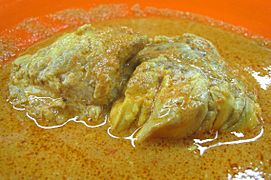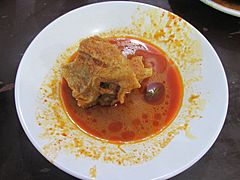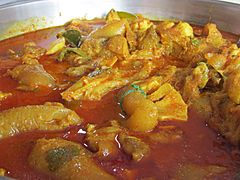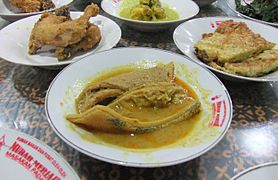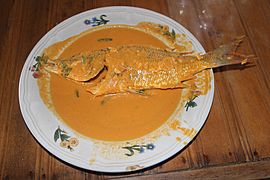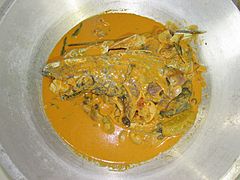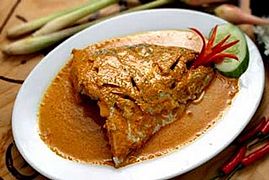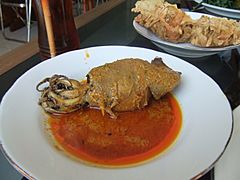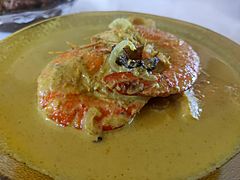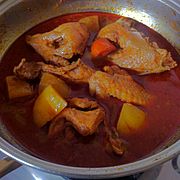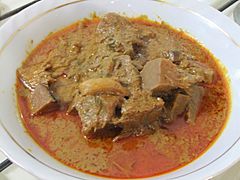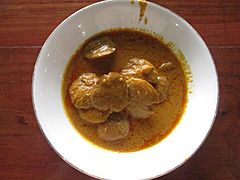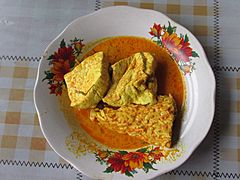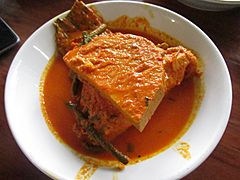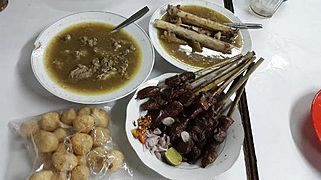Gulai facts for kids
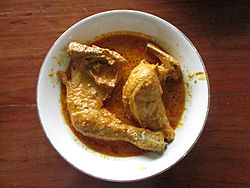
A plate of chicken gulai.
|
|
| Type | Stew |
|---|---|
| Course | Main |
| Place of origin | Indonesia |
| Region or state | Sumatra |
| Associated national cuisine | Indonesia, Malaysia, Singapore, Brunei, and Southern Thailand |
| Serving temperature | Hot and room temperature |
Gulai is a yummy, spicy stew that's popular in countries like Indonesia, Malaysia, and Singapore. It's made with lots of different ingredients, like chicken, goat meat, beef, or even fish and seafood. You can also find it with veggies like cassava leaves or unripe jackfruit.
People often call Gulai a type of curry, especially in Indonesia. But it's also a special local dish in Malaysia and Singapore. While Gulai is a common name for these curry-like dishes, these countries also have dishes called kari, which means curry.
Contents
What is Gulai?
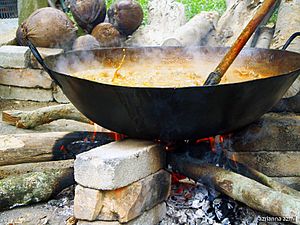
Gulai sauce is usually thick and yellowish. This color comes from a spice called turmeric. The sauce is made with many different spices. These include turmeric, coriander, black pepper, galangal, ginger, and chilli pepper. Other spices are shallot, garlic, fennel, lemongrass, cinnamon, and caraway.
All these spices are ground into a paste. Then, they are cooked in creamy coconut milk with the main ingredients. In Malaysia, they sometimes add Kerisik (toasted coconut paste) to make the sauce even thicker.
Different Gulai Styles
Gulai recipes can be a bit different depending on where you are. For example, in Java, Gulai is usually light yellow. But in Sumatra, it often has a more reddish color. In Palembang, a city in Sumatra, Gulai might include turmeric leaf and pineapple.
In West Sumatra, a leaf called ruku-ruku (a type of basil) is a must-have ingredient. However, in Java, coriander is more commonly used. Another difference is that Javanese Gulai, sometimes called gule, often has tamarind. This gives it a slightly sour taste compared to other versions.
History of Gulai
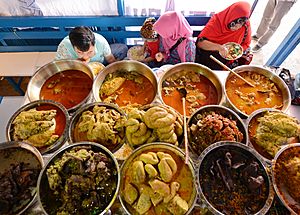
Gulai first came from the island of Sumatra in Indonesia. It's believed to be a local version of Indian curry. This happened because Indian culture influenced Southeast Asia a long time ago. Today, Gulai is popular all over the Malay Archipelago. This includes Sumatra, the Malay Peninsula, Java, and Borneo.
The thick, yellowish Gulai sauce is very common in Minangkabau cuisine. It gives a rich and spicy flavor to meats, fish, and vegetables. People often describe Gulai as juicy and spicy. Yet, it mixes different spice flavors so smoothly that it's hard to tell each spice apart.
How Gulai is Made
The ingredients for Gulai are slowly cooked in coconut milk. They are also cooked with a special mix of spices and chili pepper. The thick, golden, and spicy Gulai sauce is a famous sight in restaurants in Padang, Indonesia. In Padang, being a good cook means you can make amazing Gulai.
Some other famous dishes from Padang are often seen as types of Gulai. These include Rendang (beef cooked slowly in coconut milk and spices), asam padeh (a sour and spicy stew), and kalio (a thinner, lighter gravy).
Gulai in Malaysia
In Malaysia, a popular sour fish soup called asam pedas is sometimes called gulai tumis. In the states of Perak and Pahang, gulai tempoyak is a local favorite. This dish is often eaten daily and during special events like Hari Raya and weddings.
Negeri Sembilan is a Malaysian state known for its very spicy food. Masak lemak cili api is a type of Gulai from there. It's made with coconut milk, turmeric, and super spicy bird's eye chili. Sometimes, roti canai (a type of flatbread usually served with curry) is also served with Gulai.
The Gulai sauce in Minangkabau, Acehnese, and Malay cuisine is usually thicker. But in Java, the Gulai sauce is thinner. It's often served in soup-like dishes with pieces of mutton, beef, or other meats. Gulai is usually eaten with steamed rice.
Types of Gulai
You can find many different Gulai recipes across the Indonesian Archipelago. They are found in Minangkabau, Malay, Acehnese, and Javanese cooking. West Sumatra, in particular, has a huge variety of Gulai dishes.
|
Poultry Gulai
Meat Gulai
Insect Gulai
Offal Gulai
|
Fish and Seafood Gulai
Vegetable Gulai
|
Gallery
- Gulai variants
-
Gulai kerapu, grouper gulai, a Padang Pariaman food
-
Gulai jariang, jengkol gulai, a Padang food
-
Gulai sukun, breadfruit gulai
-
Gule kambing, goat meat Javanese gulai, It is served with goat satay
See also
 In Spanish: Gulai para niños
In Spanish: Gulai para niños



